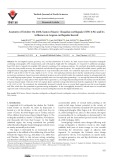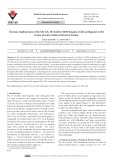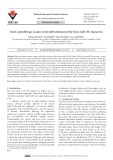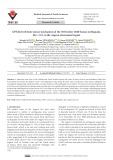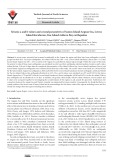
Aegean tectonics
-
We investigated rupture geometry, size, and slip distribution of October 30, 2020, Samos (Sisam)–Kuşadası earthquake combining seismographs, GPS measurements, and SAR analysis. Right after the earthquake, we measured 13 additional campaignbased GPS sites to intensify the available GPS network consisting of 10 continuous stations. We combined all available seismographs to have the best possible accuracy for mainshock and aftershock hypocenter locations. We compiled all available seismic profiles and integrated them using high-resolution bathymetry to map seismically active faults.
 11p
11p  tanmocphong
tanmocphong
 29-01-2022
29-01-2022
 13
13
 1
1
 Download
Download
-
A Mw 6.8 earthquake struck Western Turkey and Eastern Greece that occurred on October 30, 2020 in Kuşadası Gulf. The earthquake epicentre is located north of Samos Island and the focal mechanism solution shows that a normal fault was reactivated. The main shock and aftershock analysis imply that the large earthquake occurred on a north dipping normal fault which might be the western continuation of the Efes Fault in Western Turkey.
 13p
13p  tanmocphong
tanmocphong
 29-01-2022
29-01-2022
 10
10
 1
1
 Download
Download
-
The Aegean region is one of the most seismically active regions in Turkey and comprises the Hellenic Arc, Greece, and Western Turkey. The Tuzla Fault, which lies between the town of Menderes and Cape Doğanbey, is one of the major seismic threats in western Turkey due to its seismic potential to generate a major earthquake (M 6, near Doğanbey Cape in 1992) and proximity to the city of İzmir which sustained damage due to the earthquake that occurred in the Aegean Sea on October 30th, 2020.
 11p
11p  tanmocphong
tanmocphong
 29-01-2022
29-01-2022
 11
11
 1
1
 Download
Download
-
High-resolution marine seismic reflection studies on the eastern shelf of the Saros Gulf have revealed the presence of gascharged sediments across a narrow submarine valley incised by the Ganos Fault along the North Anatolian Fault system. Quaternary sediments, accumulated during glacial and interglacial periods through transgressional and progradational units, were controlled by glacio-eustatic sea-level fluctuations and tectonic deformation. The transgressional units made of upward-fining deposits created seals at their tops to form gas accumulation pockets.
 20p
20p  tanmocphong
tanmocphong
 29-01-2022
29-01-2022
 10
10
 1
1
 Download
Download
-
A submarine area close to the Turkish and Greek border between the cities of Samos-Greece and Seferihisar-Turkey has been shaked on October 30, 2020 by a Mw= 6.9 earthquake. In this study, the finite source mechanism of the Samos earthquake was investigated using geodetic methods and the coseismic behavior of the earthquake was modeled. The observed coseismic displacements at 62 sites were inverted for the fault geometry and the slips. The mainshock did not generate an on-land surface rupture. However, the uniform slip modeling shows a finite source of 43.
 20p
20p  tanmocphong
tanmocphong
 29-01-2022
29-01-2022
 7
7
 0
0
 Download
Download
-
In recent years, seismicity has increased considerably in the Aegean Sea region and there have been earthquakes in which people lost their lives. The major earthquakes, Kos Island-Gökova Bay (Mw = 6.6), Lesvos Island-Karaburun (İzmir) (Mw = 6.2) and Samos Island-Aegean Sea (Mw = 6.9) occurred in the Aegean Sea and affected Aegean region strongly. Within the scope of this study, the seismic b-value of these major earthquakes was calculated in order to perform earthquake statistical analysis.
 18p
18p  tanmocphong
tanmocphong
 29-01-2022
29-01-2022
 12
12
 0
0
 Download
Download
CHỦ ĐỀ BẠN MUỐN TÌM








